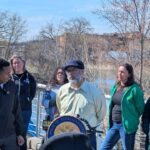Although it was called the “Fur Trade,” Europeans valued beavers for wool rather than fur. The rough texture of the beaver’s dense wooly undercoat made it easy to process into a durable, water-resistant felt that was perfect for the enormous hats fashionable in the 1600s.
Neither felt nor hats were made in New Amsterdam: beaver pelts were instead shipped to old Amsterdam. From there they were often sent on to factories in Russia where the wooly undercoat was combed out of the pelts. (Later on chemicals such as mercury would be used to separate the wool in a process called “carroting” from the reddish mercury-tinted hair ends, the toxic effects of which made many a felt worker quite literally “mad as a hatter.”)
From Russia the beaver wool was sent back to Amsterdam to be processed into felt and made into hats that were shipped all over Europe and even back to New Amsterdam. So by the time our beaver made his way from the Bronx River to the top of somebody’s head, he was a well-travelled commodity indeed. All this made beaver hats very expensive, but a well-made one would last for years, and let everyone know that you were a person of consequence.
By the early 1800s the insatiable European demand for beaver pelts had pushed the fur trade into the remotest corners of North America, and the beaver to the edge of extinction. That is, until one evening in 1825 when the Prince of Wales showed up at a London theater wearing a newfangled silk top-hat. A new fashion took hold, and the beleaguered beaver won a reprieve.
— S.P. DeVillo





